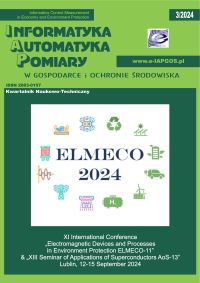INTELIGENTNY WÓZEK INWALIDZKI Z NAPĘDEM ELEKTRYCZNYM: PROBLEMY I WYZWANIA W PODEJŚCIU PRODUKTOWYM
Serge Ageyev
Mobilis Robotics LLC, Kraków, Poland (Polska)
http://orcid.org/0000-0002-9451-6766
Andrii Yarovyi
a.yarovyy@vntu.edu.ua1Mobilis Robotics LLC, Kraków, Poland, 2Vinnytsia National Technical University, Department for Computer Science, Vinnytsia, Ukraine (Ukraina)
http://orcid.org/0000-0002-6668-2425
Abstrakt
Niniejszy artykuł koncentruje się na omówieniu problemów i wyzwań dotyczących nowego produktu, jakim jest Smart Power Wheelchair (SPW), czyli inteligentny asystent używany w elektrycznych wózkach inwalidzkich w warunkach domowych. Zwrócono szczególnie uwagę na ukazanie SPW jako nowego produktu konsumenckiego na rynku dóbr. Przedstawione zostały główne problematyczne aspekty i wyzwania dla SPW, które mogą pojawić się w warunkach rzeczywistych. Artykuł zawiera również propozycje dotyczące tworzenia wymagań systemowych oraz ich klasyfikacji. W kolejnej części artykułu przedstawiono wyniki badań, zrealizowanych w ramach projektu Mobilis, dzięki którym wdrożono szereg zmian w produkcie. Ponadto autorzy zapewniają o planowanych dalszych badaniach nad rozwojem produktu. Należy zwrócić uwagę, że wprowadzenie technologii SPW otwiera możliwości efektywnej integracji z nowymi metodami komunikacji (w tym z interfejsami mózg-komputer, z ang. brain-computer interfaces – BCI), z których szczególną korzyść będą miały osoby z niepełnosprawnością ruchową.
Słowa kluczowe:
elektryczny wózek inwalidzki, inteligentne systemy, systemy wspomagania napędu, autopilot, interakcja człowiek-komputerBibliografia
Ageyev S.: Product Approach to Autonomous Power Wheelchair. ResearchGate. September 2020 [http://researchgate.net/publication/344045604_Product_Approach_to_Autonomous_Power_Wheelchair].
Google Scholar
Ageyev S., Yarovyi A.: Intelligent Assist Technology for Power Wheelchair: Problems and Challenges of Product Approach – Brain Controlling Technology for Assistive Devices. Tech Day Online Meeting – DEMACH Event- und Veranstaltungs GmbH, Berlin, 2021.
Google Scholar
Ageyev S., Yarovyi A.: Intelligent Assistant for Power Wheelchair. L Scientific and Technical Conference of Vinnytsia National Technical University 2021, [https://conferences.vntu.edu.ua/index.php/all-fitki/all-fitki-2021/paper/view/12943/10866].
Google Scholar
Arledge S., Armstrong W., Babinec M., Dicianno B. E., Digiovine C., Dyson-Hudson T., Stogner J.: RESNA Wheelchair Service Provision Guide. RESNA (NJ1) 2011.
Google Scholar
Cascado D. et al.: A Smart Electric Wheelchair Using UPnP. In: Cai Y., Abascal J. (eds): Ambient Intelligence in Everyday Life. Lecture Notes in Computer Science 3864. Springer, Berlin, Heidelberg 2006, [https://doi.org/10.1007/11825890_14].
DOI: https://doi.org/10.1007/11825890_14
Google Scholar
Fehr L, Langbein W. E., Skaar S. B.: Adequacy of power wheelchair control interfaces for persons with severe disabilities: a clinical survey. J Rehabil Res Dev. 37(3), 2000, 353-60 [https://www.ncbi.nlm.nih.gov/pubmed/10917267].
Google Scholar
Ghorbel M., Pineau J., Gourdeau R. et al.: A Decision-Theoretic Approach for the Collaborative Control of a Smart Wheelchair. Int. J. of Soc. Robotics 10, 2018, 131–145 [https://doi.org/10.1007/s12369-017-0434-7].
DOI: https://doi.org/10.1007/s12369-017-0434-7
Google Scholar
Hartman A., Nandikolla V. K.: Human-Machine Interface for a Smart Wheelchair. Journal of Robotics 2019 [https://doi.org/10.1155/2019/4837058].
DOI: https://doi.org/10.1155/2019/4837058
Google Scholar
Joshi M. K., Gupta M. V., Gosavi M. M., Wagh M. S.: A multifunctional smart wheelchair. Int. J. Adv. Res. Electron. Commun. Eng. 4(5), 2015, 1281–1284.
Google Scholar
Karmarkar A. M., Dicianno B. E., Graham J. E., Cooper R., Kelleher A., Cooper R. A.: Factors associated with provision of wheelchairs in older adults. Assistive Technology 24(3), 2012, 155–167.
DOI: https://doi.org/10.1080/10400435.2012.659795
Google Scholar
Leaman J., La H. M.: A Comprehensive Review of Smart Wheelchairs: Past, Present, and Future. IEEE Transactions on Human-Machine Systems 47(4), 2017, 486–499 [http://doi.org/10.1109/THMS.2017.2706727].
DOI: https://doi.org/10.1109/THMS.2017.2706727
Google Scholar
Madokoro H., Shirai K., Sato K., Shimoi N.: Basic Design of Visual Saliency Based Autopilot System Used for Omnidirectional Mobile Electric Wheelchair. Computer Science and Information Technology 3(5), 2015, 171–186 [http://doi.org/10.13189/csit.2015.030503].
DOI: https://doi.org/10.13189/csit.2015.030503
Google Scholar
Mobilis Electric Wheelchair Autopilot [http://mobilis.io] (available: 16.08.2021).
Google Scholar
Sanders D. et al.: Intelligent Control and HCI for a Powered Wheelchair Using a Simple Expert System and Ultrasonic Sensors. In: Arai K., Kapoor S., Bhatia R. (eds): Intelligent Systems and Applications. IntelliSys 2020. Advances in Intelligent Systems and Computing 1252. Springer, Cham. [https://doi.org/10.1007/978-3-030-55190-2_42].
DOI: https://doi.org/10.1007/978-3-030-55190-2_42
Google Scholar
Sanders D., Okono O., Langner M., Hassan M., Khaustov S., Omoarebun P.: Using a Simple Expert System to Assist a Powered Wheelchair User. In: Bi Y., Bhatia R., Kapoor S. (eds): Intelligent Systems and Applications. IntelliSys 2019. Advances in Intelligent Systems and Computing 1037. Springer, Cham. [https://doi.org/10.1007/978-3-030-29516-5_50].
DOI: https://doi.org/10.1007/978-3-030-29516-5_50
Google Scholar
Simpson R. C.: Smart wheelchairs: A literature review. Journal of Rehabilitation Research and Development 42(4), 2005, 423–436.
DOI: https://doi.org/10.1682/JRRD.2004.08.0101
Google Scholar
Simpson R. C., LoPresti E. F., Cooper R. A.: How many people would benefit from a smart wheelchair? Journal of Rehabilitation Research and Development 45(1), 2008, 53–72.
DOI: https://doi.org/10.1682/JRRD.2007.01.0015
Google Scholar
Simpson R., LoPresti E., Hayashi S., Nourbakhsh I.: The Smart Wheelchair Component System. Journal of Rehabilitation Research & Development 41(3B), 2004, 429–442 [https://www.rehab.research.va.gov/jour/04/41/3b/simpson.html]
DOI: https://doi.org/10.1682/JRRD.2003.03.0032
Google Scholar
Sonenblum S. E., Sprigle S., Harris F. H., Maurer C. L.: Characterization of Power Wheelchair Use in the Home and Community 2008 [https://smartech.gatech.edu/bitstream/handle/1853/36721/Sonenblum_etal_CharacterizationofPowerWCUse_ArchivesPhysMed&Rehab2008_SmartTechversion.pdf]
DOI: https://doi.org/10.1016/j.apmr.2007.09.029
Google Scholar
Sturnieks D. L., George R. St, Lord S. R.: Balance disorders in the elderly, Neurophysiologie Clinique/Clinical Neurophysiology 38(6), 2008, 467–478 [https://doi.org/10.1016/j.neucli.2008.09.001].
DOI: https://doi.org/10.1016/j.neucli.2008.09.001
Google Scholar
Viswanathan P. et al.: Smart Wheelchairs in Assessment and Training (SWAT): State of the Field 2018 [https://agewell-nce.ca/publications/position-papers].
DOI: https://doi.org/10.4324/9781315368788-5
Google Scholar
Viswanathan P., Zambalde E. P., Foley G. et al.: Intelligent wheelchair control strategies for older adults with cognitive impairment: user attitudes, needs, and preferences. Autonomous Robots 41, 2017, 539–554 [https://doi.org/10.1007/s10514-016-9568-y].
DOI: https://doi.org/10.1007/s10514-016-9568-y
Google Scholar
White Paper on Aging Society 2012, Cabinet Office, Government of Japan, 2013.
Google Scholar
Autorzy
Serge AgeyevMobilis Robotics LLC, Kraków, Poland Polska
http://orcid.org/0000-0002-9451-6766
Autorzy
Andrii Yarovyia.yarovyy@vntu.edu.ua
1Mobilis Robotics LLC, Kraków, Poland, 2Vinnytsia National Technical University, Department for Computer Science, Vinnytsia, Ukraine Ukraina
http://orcid.org/0000-0002-6668-2425
Statystyki
Abstract views: 313PDF downloads: 520
Licencja

Utwór dostępny jest na licencji Creative Commons Uznanie autorstwa – Na tych samych warunkach 4.0 Miedzynarodowe.
Inne teksty tego samego autora
- Andrii Yarovyi, Dmytro Kudriavtsev, TWORZENIE WYSOCE WYSPECJALIZOWANYCH CHATBOTÓW DO ZAAWANSOWANEGO WYSZUKIWANIA , Informatyka, Automatyka, Pomiary w Gospodarce i Ochronie Środowiska: Tom 14 Nr 1 (2024)








